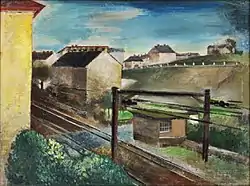Friedl Dicker-Brandeis
Frederika "Friedl" Dicker-Brandeis (30 July 1898, in Vienna – 9 October 1944, in Auschwitz-Birkenau), was an Austrian artist and educator murdered by the Nazis in the Auschwitz-Birkenau extermination camp.
Frederika "Friedl" Dicker-Brandeis | |
|---|---|
.jpg.webp) | |
| Born | Frederika Dicker July 30, 1898 |
| Died | October 9, 1944 (aged 46) |
| Nationality | Austrian |
| Known for | Painting, Drawing |
| Spouse |
Pavel Brandeis (m. 1936) |
Biography
Frederika Dicker was born in Vienna on 30 July 1898, into a poor Jewish family. Her father was a shop-assistant; her mother, Karolina, died in 1902. She married Pavel Brandeis in 1936 and used the hyphenated surname after that. Dicker-Brandeis was a student of Johannes Itten at his private school in Vienna, and later followed Itten to study and teach at the Weimar Bauhaus. She was involved in the textile design, printmaking, bookbinding, and typography workshops there from 1919-1923. After leaving the Bauhaus, she worked as an artist and textile designer in Berlin, Prague, and Hronov. Dicker-Brandeis wrote to a friend in 1940:[1]
I remember thinking in school how I would grow up and would protect my students from unpleasant impressions, from uncertainty, from scrappy learning... Today only one thing seems important — to rouse the desire towards creative work, to make it a habit, and to teach how to overcome difficulties that are insignificant in comparison with the goal to which you are striving.
In World War II
Dicker-Brandeis and her husband, Pavel Brandeis, were deported to the Terezín "model ghetto" on December 17, 1942. During her time at Terezín, she gave art lessons and lectures with art supplies she smuggled into the camp.[2] She helped to organize secret education classes for the 600 children of Terezín. She saw drawing and art as a way for the children to understand their emotions and their environment. Dicker-Brandeis insisted that each child must sign their own name, not allowing them to become invisible or anonymous. [2] In this, she persisted in pursuing her goal "to rouse the desire towards creative work."[1]
In September 1944, Brandeis was transported to Auschwitz. Dicker-Brandeis volunteered for the next transport to join him. Before she was taken away, she entrusted Raja Engländerova, chief tutor of Girls' Home L 410, with two suitcases containing 4,500 drawings. Dicker-Brandeis was murdered in Birkenau on 9 October 1944.[3] Her husband survived.
Legacy
After the war, Willy Groag, director of the Girls' home L 410, brought the suitcases with children's drawings to the Jewish Community in Prague. From the nearly 660 authors of the drawings, 550 were murdered in the Holocaust. The drawings are now in the Jewish Museum in Prague's collection, with some on display in the Pinkas Synagogue.
In 1999, an exhibition of Dicker-Brandeis' work, organized by the Simon Wiesenthal Center and curated by Elena Makarova of Israel, opened in Vienna. It then toured to the Czech Republic, Germany, Sweden, France, USA, and Japan. Tokyo Fuji Art Museum founder Daisaku Ikeda, who was instrumental in bringing the exhibit to Japan, commented:
The various artworks left behind by this great woman and the children of Terezin are their legacy to the present, to all of us today. They demand that we continue in our quest for a society that truly treasures human life, transcending all differences of race, religion, politics and ideology. It remains my heartfelt hope that this exhibit may provide a moment of introspection for its viewers, a moment for us to reaffirm the importance of our rights as human beings and the value of life itself.
Her work was included in the 2019 exhibition City Of Women: Female Artists in Vienna from 1900 to 1938 at the Österreichische Galerie Belvedere.[4]
Gallery
 Výslech I
Výslech I Nádraží
Nádraží
Notes
- Salamon, Julie (September 10, 2004). "Keeping Creativity Alive, Even in Hell". The New York Times.
- Brown, Kellie (2020). The sound of hope: Music as solace, resistance and salvation during the holocaust and world war II. McFarland. pp. 99–100.
- Sterling, Eric (2005). Life in the ghettos during the Holocaust. Syracuse University Press. p. 196. ISBN 978-0-8156-0803-5.
- "City of Women". Belvedere Museum Vienna. Retrieved 26 June 2020.
Bibliography
- Susan Goldman Rubin: Fireflies in the Dark: The Story of Friedl Dicker-Brandeis and the Children of Terezin, Holiday House Inc New York, 2000, ISBN 0-8234-1681-X
- Elena Makarova: Friedl, Dicker-Brandeis, Vienna 1898- Auschwitz 1944: the artist who inspired the children's drawings of Terezin ", 1st edition. Tallfellow/Every Picture Press, in association with Simon Wiesenthal Center/Museum of Tolerance, Los Angeles, 2001, ISBN 0-9676061-9-5
External links
 Media related to Friedl Dicker-Brandeisová at Wikimedia Commons
Media related to Friedl Dicker-Brandeisová at Wikimedia Commons- Entry in Jewish Women: A Comprehensive Historical Encyclopedia
- More about Friedl Dicker-Brandeis
- The Pinkas Synagogue
- Exhibition Tokyo Fuji Art Museum April 2002
- Jewish Museum (1109 Fifth Avenue, New York City) from September 10, 2004 to January 16, 2005
- http://makarovainit.com/friedl/home.html
- https://web.archive.org/web/20101215004606/http://www.jewishmuseum.cz/en/afdb.htm
- https://web.archive.org/web/20140116202409/http://www.thejewishmuseum.org/exhibitions/FDB
- Documents about Friedl Dicker-Brandeis in the collection of the Jewish Museum Prague.
- about Friedl Dicker-Brandeis in Yad Vashem website